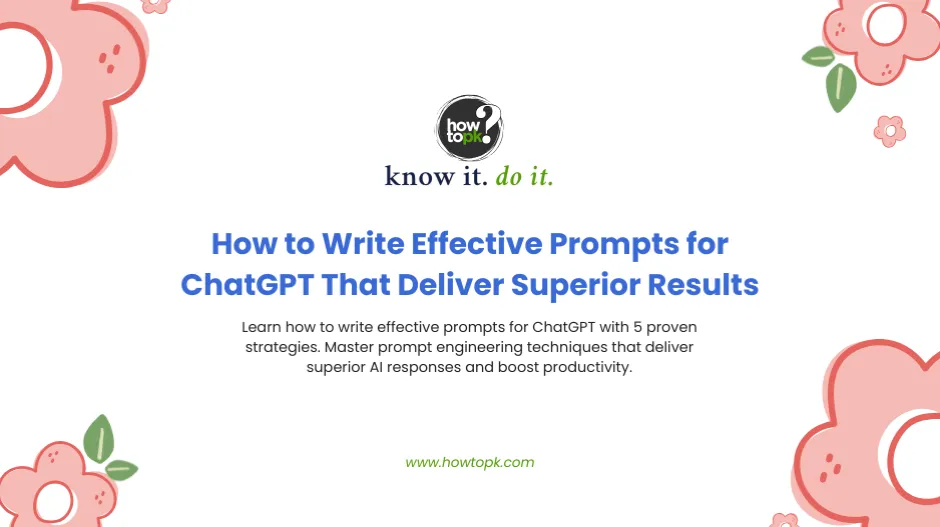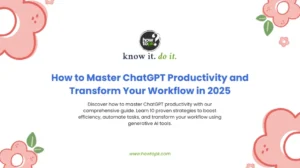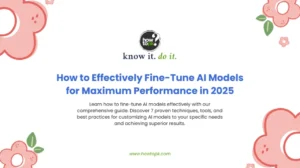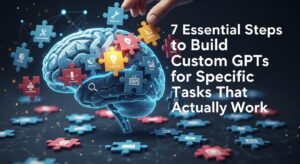Have you ever wondered why some people seem to get incredible results from ChatGPT while your interactions feel frustrating and unproductive? The secret lies not in the AI itself, but in how you communicate with it. Writing effective prompts for ChatGPT is both an art and a science that can transform your AI experience from mediocre to extraordinary.
Before we dive deep into the strategies, let’s start with a fundamental question: What makes one prompt more effective than another? Think about your recent ChatGPT interactions. Can you identify moments when the AI seemed to “get” exactly what you wanted versus times when it completely missed the mark?
Understanding the Foundation: What Makes Prompts Work?
The effectiveness of your effective prompts for ChatGPT depends on several key principles that mirror how humans communicate best. Just as you wouldn’t ask a colleague for help with a vague “can you help me with this project?” you shouldn’t expect ChatGPT to read your mind.
Consider this: When you’re explaining something complex to a friend, what do you naturally do? You provide context, break down your request into clear parts, and specify what kind of response you’re looking for. The same principles apply when crafting prompts for AI.
The Psychology Behind Prompt Engineering
Effective prompt writing taps into how large language models process and generate information. These systems work by predicting the most likely continuation of text based on patterns learned from vast datasets. When you provide clear, specific context and structure, you’re essentially guiding the model toward the type of response pattern that best serves your needs.
Strategy 1: Master the Art of Specificity
The first pillar of writing effective prompts for ChatGPT involves replacing vague requests with precise, detailed instructions. This doesn’t mean writing novels – it means being strategically specific about what you want.
Before and After Examples
Ineffective: “Write about marketing.”
Effective: “Write a 500-word blog post about email marketing strategies for small e-commerce businesses, focusing on segmentation techniques that increase conversion rates by at least 15%.”
Notice how the effective version specifies:
- Format (blog post)
- Length (500 words)
- Topic scope (email marketing for e-commerce)
- Target audience (small businesses)
- Specific focus (segmentation techniques)
- Desired outcome (15% conversion increase)
The Specificity Framework
When crafting your next prompt, ask yourself these guiding questions:
- Who is the intended audience?
- What exact format do you need?
- Why are you creating this content?
- How detailed should the response be?
- When will this be used (context matters)?
Try applying this framework to a current project you’re working on. How would you transform a general request into a specific, actionable prompt?
Strategy 2: Leverage Role-Based Prompting
One of the most powerful techniques for generating effective prompts for ChatGPT involves asking the AI to adopt a specific role or persona. This approach helps the model access relevant knowledge patterns and communication styles.
The Role Assignment Technique
Instead of generic requests, frame your prompts by assigning ChatGPT a relevant professional role:
Example Structure: “Act as a [specific professional role] with [X years of experience] in [specific field]. [Your specific request with context].”
Practical Application: “Act as a senior financial analyst with 10 years of experience in SaaS companies. Analyze this quarterly revenue data and provide three actionable insights for improving customer retention rates.”
Most Effective Roles by Use Case
Use Case | Recommended Role | Why It Works |
Creative Writing | Bestselling novelist, screenwriter | Accesses narrative structure patterns |
Business Analysis | Management consultant, industry expert | Provides strategic thinking frameworks |
Technical Explanation | Senior engineer, university professor | Balances technical accuracy with clarity |
Content Marketing | Digital marketing strategist | Understands audience psychology and conversion |
What role would be most valuable for your current AI interactions? Consider how adopting this approach might change the quality of responses you receive.
Strategy 3: Structure Your Prompts Like a Professional Brief
Professional communicators know that structure dramatically impacts comprehension and results. The same principle applies to effective prompts for ChatGPT. By organizing your requests systematically, you help the AI understand both what you want and how to deliver it effectively.
The CLEAR Framework
Context: Set the scene and background Length: Specify desired response length Example: Provide examples when helpful Audience: Define who will consume this content Result: Describe the specific outcome you want
Framework in Action:
Context: I'm preparing a presentation for senior executives about our company's digital transformation.
Length: Need 3-5 key talking points, each with supporting data.
Example: Similar to how Netflix transformed from DVD to streaming.
Audience: C-suite executives with limited technical background.
Result: Persuasive points that secure budget approval for our initiative.
Advanced Structuring Techniques
For complex requests, consider breaking your prompt into numbered sections:
- Background: What led to this need?
- Objective: What are you trying to achieve?
- Constraints: What limitations exist?
- Success criteria: How will you measure effectiveness?
This structured approach not only improves AI responses but also forces you to clarify your own thinking. Have you noticed how writing down requirements often reveals gaps in your original concept?
Strategy 4: Use Examples and Templates Strategically
One of the most underutilized aspects of creating effective prompts for ChatGPT involves providing high-quality examples. The AI learns patterns exceptionally well, and strategic examples can dramatically improve output quality.
The Power of Pattern Recognition
When you provide examples, you’re essentially teaching ChatGPT the specific style, tone, and structure you prefer. This works because language models excel at pattern matching and continuation.
Example-Driven Prompt: “Write product descriptions following this style:
Example: ‘Transform your morning routine with the UltraBlend Pro 3000. This isn’t just another blender – it’s your personal nutrition laboratory. With surgical-grade stainless steel blades and whisper-quiet operation, you’ll create restaurant-quality smoothies that fuel your ambitions.’
Now write a similar description for [your product].”
Template Integration Strategy
Create reusable templates for common tasks. Here’s a content creation template that consistently generates effective results:
Topic: [Specific subject]
Angle: [Unique perspective or hook]
Audience: [Target demographic with pain points]
Goal: [Specific action you want readers to take]
Tone: [Professional, conversational, urgent, etc.]
Length: [Word count or time to read]
Key points to cover: [3-5 bullet points]
Call to action: [Specific next step]
Consider developing templates for your most frequent ChatGPT use cases. What repetitive tasks could benefit from a standardized approach?
Strategy 5: Implement Iterative Refinement
The final strategy for mastering effective prompts for ChatGPT involves treating prompt writing as an iterative process rather than a one-shot attempt. Professional prompt engineers rarely get perfect results on the first try – they refine and optimize based on results.
The Refinement Process
- Initial prompt: Start with your best attempt
- Evaluate output: Identify what worked and what didn’t
- Targeted adjustment: Make specific improvements
- Test and measure: Compare results
- Document success: Save effective prompts for reuse
Common Refinement Patterns
When your initial prompt doesn’t deliver desired results, try these targeted adjustments:
If the response is too generic:
- Add more specific constraints
- Provide better examples
- Define success criteria more precisely
If the response misses the mark:
- Clarify the context or background
- Specify the intended audience
- Break complex requests into smaller parts
If the tone is wrong:
- Add explicit tone instructions
- Provide examples of desired communication style
- Specify the relationship dynamic (formal, casual, expert-to-expert)
Building Your Prompt Library
Successful prompt engineers maintain libraries of tested, effective prompts. Start building yours by:
- Saving prompts that generate exceptional results
- Noting what modifications improved output quality
- Creating variations for different contexts
- Sharing successful patterns with team members
Advanced Techniques for Power Users
Once you’ve mastered the fundamentals of effective prompts for ChatGPT, these advanced techniques can take your results to the next level:
- Chain-of-Thought Prompting: Guide ChatGPT through step-by-step reasoning by explicitly requesting thought processes:
- “Before providing your recommendation, walk me through your reasoning process step-by-step. Consider the pros and cons of each option, then explain why you reached your conclusion.”
- Constraint-Based Creativity: Paradoxically, adding constraints often improves creative output:
- “Write a compelling product headline using exactly 7 words, including the benefit ‘saves time,’ and ending with a question.”
- Multi-Perspective Analysis: Request analysis from multiple viewpoints:
- “Analyze this marketing strategy from three perspectives: a customer, a competitor, and a financial analyst. Provide distinct insights from each viewpoint.”
Measuring and Optimizing Your Prompt Performance
How do you know if your effective prompts for ChatGPT are actually working? Developing measurement criteria helps you continuously improve your prompt engineering skills.
Key Performance Indicators
- Relevance: Does the response directly address your request?
- Completeness: Are all aspects of your prompt addressed?
- Actionability: Can you immediately use the output?
- Accuracy: Is the information reliable and factual?
- Efficiency: Did you get quality results without excessive back-and-forth?
A/B Testing Your Prompts
Try comparing different prompt versions for the same task:
Version A: Direct request Version B: Role-based prompt Version C: Example-driven approach
Track which versions consistently deliver superior results for different types of tasks.
Common Pitfalls and How to Avoid Them
Even experienced users make these mistakes when crafting effective prompts for ChatGPT:
- Information Overload: Including too much irrelevant context Solution: Focus on information that directly impacts the desired output
- Ambiguous Success Criteria: Not defining what “good” looks like Solution: Specify measurable outcomes and quality standards
- Ignoring Context Windows: Creating prompts too long for effective processing Solution: Break complex requests into sequential, focused prompts
- Over-Reliance on Single Attempts: Expecting perfection from first prompts Solution: Plan for iteration and refinement
Tools and Resources for Prompt Engineering
Enhance your effective prompts for ChatGPT development with these valuable resources:
Essential Reading
- OpenAI’s Prompt Engineering Guide – Official best practices
- Anthropic’s Prompt Library – Tested prompt templates
- Learn Prompting – Comprehensive prompt engineering course
Prompt Testing Platforms
- PromptPerfect: AI-powered prompt optimization
- Promptbase: Marketplace for tested prompts
- Botify: Prompt testing and analytics
Community Resources
- r/ChatGPT on Reddit for real-world examples
- Prompt engineering Discord communities
- LinkedIn groups focused on AI productivity
The Future of Prompt Engineering
As AI systems become more sophisticated, the art of writing effective prompts for ChatGPT continues evolving. Understanding emerging trends helps you stay ahead:
Emerging Patterns
- Multi-modal prompting: Combining text, images, and data
- Dynamic prompting: Adapting prompts based on AI responses
- Collaborative prompting: Team-based prompt development
Skills to Develop
- Understanding AI model capabilities and limitations
- Recognizing bias and ensuring diverse perspectives
- Balancing efficiency with creativity in prompt design
Taking Action: Your Next Steps
Now that you understand the strategies for creating effective prompts for ChatGPT, it’s time to put this knowledge into practice. Start by identifying one area where better AI interactions could significantly impact your work or personal projects.
Consider these immediate actions:
- Audit your current prompts: Review recent ChatGPT interactions and identify improvement opportunities
- Choose one strategy: Pick the technique that most directly addresses your current challenges
- Create a test prompt: Apply your chosen strategy to a real project
- Measure results: Compare the new approach to your previous methods
- Build your library: Document successful prompts for future use
Mastering prompt engineering is a skill that develops over time. Each interaction provides opportunities to refine your approach and discover new techniques.
The investment in learning to write effective prompts for ChatGPT pays dividends across every aspect of your AI interactions. Whether you’re creating content, analyzing data, solving problems, or exploring creative projects, better prompts lead to better results, saved time, and increased satisfaction with AI assistance.
What will you create with your new prompt engineering skills? The possibilities are as limitless as your imagination and as powerful as your ability to communicate clearly with AI.











